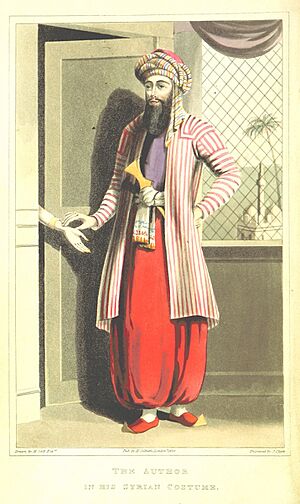Richard Robert Madden facts for kids
Quick facts for kids
Richard Robert Madden
|
|
|---|---|

Richard Robert Madden in 1858
|
|
| Born | 22 August 1798 |
| Died | 5 February 1886 (aged 87) Booterstown, Ireland
|
| Known for |
|
| Children | Thomas More Madden (son) |
Richard Robert Madden (born August 22, 1798 – died February 5, 1886) was an Irish doctor, writer, and historian. He was also a strong supporter of the movement to end slavery, known as an abolitionist. Madden worked for the British government to help enforce anti-slavery rules, especially in places like Jamaica. He also wrote important books about Irish history.
Contents
Early Life and Education
Richard Robert Madden was born in Dublin, Ireland, on August 22, 1798. His father, Edward Madden, was a silk maker. Richard was one of many children in his large family.
He went to private schools and later began training to become a doctor in Athboy, County Meath. He continued his medical studies in famous cities like Paris, Italy, and London. During his time in Naples, Italy, he met Lady Blessington and her friends. From 1824 to 1827, he worked as a journalist in the Middle East, a region known as the Levant. He later wrote books about his travels there.
In 1828, Madden married Harriet Elmslie. For the next five years, he worked as a doctor in Mayfair, London.

Fighting Against Slavery
Richard Madden became very involved in the movement to end slavery. Even though the transatlantic slave trade (shipping enslaved people across the Atlantic) had been made illegal in the British Empire in 1807, slavery itself was still allowed.
From 1833, Madden started working for the British government. He was sent to Jamaica as a special judge. His job was to help free the enslaved people there, following the rules of the 1833 Slavery Abolition Act.
In 1835, he moved to Havana, Cuba. There, he became the Superintendent for freed Africans. In 1839, he left Cuba and traveled to New York. He played an important role by giving evidence to help the enslaved people who had taken control of the slave ship Amistad.
In 1840, Madden was appointed as a special investigator for the British government. His mission was to find out how the slave trade was still happening on the west coast of Africa, even though it was illegal. Madden discovered that some merchants in London were secretly helping slave traders. He also found that forms of slavery still existed in all the British settlements along the coast. He especially criticized the actions of George Maclean, who was the Governor of Cape Coast Castle.
Later in his career, Madden moved to Western Australia in 1848 to work as the colonial secretary. However, he and his wife returned to Dublin in 1849 after their oldest son passed away. In 1850, he became the secretary of the Office for Loan Funds in Dublin.
Madden also continued his fight against slavery in Cuba. He spoke at the General Anti-Slavery Convention in London, sharing important information about slavery in Cuba.
Later Life and Death
Richard Robert Madden passed away at his home in Booterstown, near Dublin, in 1886. He was buried in Donnybrook Cemetery.
Published Works

Richard Madden was a very active writer. Besides his travel diaries, he wrote a very important historical book called The United Irishmen, their lives and times. This book was published in many volumes between 1842 and 1860. It contains many details about the Irish Rebellion of 1798. He gathered information from people who had been involved in the rebellion and from the families of those who had passed away.
Some of his other books include:
- The Mussulman. (1830)
- The infirmities of genius illustrated... (1833)
- A Twelvemonth’s Residence in the West Indies... (1835) – This book includes his observations from his time in Jamaica and accounts from Muslim African enslaved people.
- Poems by a slave in the island of Cuba... (1840) – Madden translated poems by a formerly enslaved Cuban poet, Juan Francisco Manzano.
- The Connexion between the Kingdom of Ireland and the Crown of England... (1845)
- The History of the Penal Laws Enacted Against Roman Catholics (1847)
- The Life and Times of Robert Emmet, Esq. (1847)
- The island of Cuba: its resources, progress, and prospects... (1849)
- The shrines and sepulchres of the Old and New World... (1851)
- The Life and Martyrdom of Savonarola... (1853)
- The Literary Life and Correspondence of the Countess of Blessington (1855)
- Phantasmata ; or, Illusions and fanaticisms of Protean forms... (1857)
- The Turkish Empire. In its Relations with Christianity and Civilization. (1862)
- Galileo and the Inquisition (1863)
- Historical Notice of Penal Laws Against Roman Catholics... (1865)
- The history of Irish periodical literature... (1867)
- The memoirs (chiefly autobiographical) from 1798 to 1886... (1891) – This book was edited by his son.
Some of Madden's original writings and documents are kept at McGill University in Canada, in the Osler Library of the History of Medicine. He also wrote poetry for The Nation, an Irish newspaper.
Family Life
Richard Madden was married to Harriet Elmslie, who passed away in 1888. They had three sons, one of whom was Thomas More Madden, who also became a doctor and writer. Harriet was born in 1801 and was the youngest of 21 children. Her father, John Elmslie, owned many enslaved people on his plantations in Jamaica. While living in Cuba, Harriet converted to Roman Catholicism.

